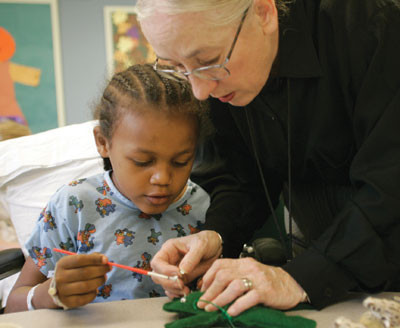Back

Children’s Hospital of Pittsburgh can be a sad place.
Often it’s an inspiring place. But for kids in the
hospital for a long stay, it can be a boring place. Add
volunteers from neighboring Carnegie Museum of Natural
History, and once a week it’s also a very busy learning
place.
In the ninth floor activity room, a group of kids
ages 3 to 9 dressed in colorful pajamas and hospital gowns
gather
around a table just their size, gluing small puffs of cotton
onto paper rabbits. Each child is given a plaster baby
bunny and a small paper cup filled with cut raffia to mimic
dried grass.
“Do you know what the mother bunny does then?” asks Lenore Adler,
program specialist for outreach at Carnegie Museum of Natural History. “She
pulls fur from her own body to make the nest soft for her baby bunny.” Impressed
by this news, the kids quickly pull from a chunk of cotton to line their cups,
making the nest comfortable for their own baby bunnies.
Adler shows a mounted
rabbit skeleton to the older kids remaining at the table. “See the
extra long legs?” she
asks. “See the big teeth? That’s why you
never pet a wild rabbit.”
This natural history
lesson is one of dozens shared by way of Carnegie Museum
of Natural History’s Museum
on the Move program, which for 25 years has delivered
the resources of the museum to special-needs children.
Once
a week at Children’s, volunteers share lessons
about dinosaurs, Native Americans, backyard birds, fabulous
felines,
or rocks and minerals.
The programs are structured to
be flexible in their complexity depending on the age
and interest of the audience—with
any given week being different, usually a mix from toddlers
to teens. According to Carol Lerberg, a volunteer with
the program for 20 years, dinosaurs are the most popular,
no matter the age. “The little kids play with the
dinosaur toys, and the older kids look at the teeth and
fossils.” A Short Walk, A Big Step
On a spring day in 1982, Carnegie Museum of Natural History
educator Diane Grzybek, now chair of the museum’s
division of education, made the short walk from the Oakland
museum over to Children’s Hospital, a box of materials
all about dinosaurs in her arms. It was a simple gesture:
take some of what kids love about the museum to children
who can’t visit the museum because of illness.
Grzybek gives credit for the idea to Sally Randall,
a museum docent who a year earlier had wondered out loud
why the
museum couldn’t travel outside its own walls to people
who could really use a wonderful diversion. Still today,
Museum on the Move is a one-of-kind program. “There
really is nothing like it in the country,” Grzybek
notes.
Today, Museum on the Move visits more than 60 organizations,
including acute-care hospitals, elementary schools, camps,
Head Start centers, and several women’s shelters.
In 2005, volunteers presented some 600 programs to more
than 8,500 children.
“
It is a very labor-intensive program,” says Grzybek,
who was the first director of the program. “It’s
a lot of work for the volunteers, but it’s a labor
of love. Once they see kids get involved, the volunteers
get hooked.”
A Wednesday morning staple at Children’s,
volunteers conduct different presentations simultaneously
on three
floors. And Children’s keeps asking them back. “It’s
interesting
and educational—and a distraction.If kids can’t
make it to the activity room, volunteers go to their bedside,” says
Denise Esposto, manager of the Child Life department at
the hospital. She’s
responsible for the activities that address the emotional
and social needs of their patients.
“
The program works on a compassionate, human level,” says
Adler, who joined Museum on the Move in 1997.
Like Gryzbek before her, she is the program’s only
full-time paid staff member. Still, Adler points out that
a lot has
changed
over the past 25 years.
Eleven volunteers now round out
the program. The museum gets to store materials at Children’s
Hospital for its weekly presentations. And Museum on
the Move staff
now even get to use a van for their special brand of special
deliveries.
Back
| Top |